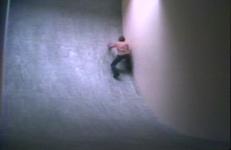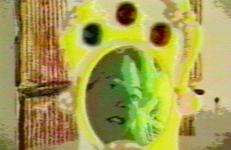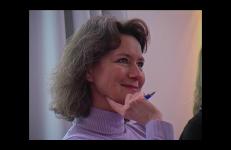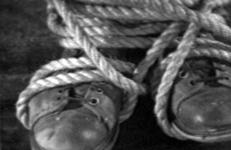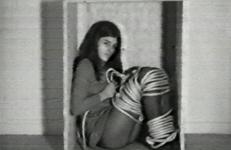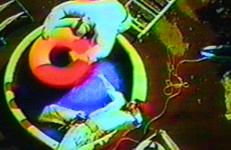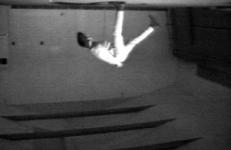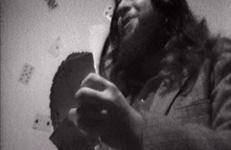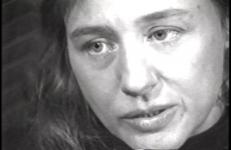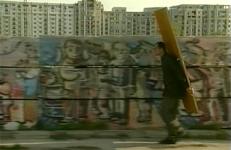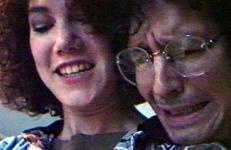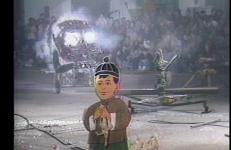This black and white drama of romance, adventure and outer space intervention was mounted at the San Francisco Art Institute. The plot concerns two groups of missionaries who depart for a tropical island inhabited by a population of attractive denizens who are ruled by a libido-fueled queen. She in turn is guided by the Star People who have their own carnal urges and the result is volcanic. The $400 budget guarantees cheap thrills and makes an explosive vehicle for the queen of these dime store dynamos: Linda Martinez (our Sharon Stone).
Performance
In Queens on the Media Scene, East Village drag queen Linda Simpson (of My Comrade zine) joins Glennda to discuss the explosion of drag in the mainstream media, and the pair interview passers-by on the streets of Midtown Manhattan. They discuss the rising acceptance of drag in the mainstream, in part due to the media presence of RuPaul; the potential taming of drag or its normalization; and an ambition to preserve the more taboo aspects of drag expression in the face of increasing popularization.
On a gradually inclined plane, attempts are made to scale the rise, and rubber shoe marks leave evidence of the point where all of humanity fails.
This title is also available on Sympathetic Vibrations: The Videoworks of Paul Kos.
A massive video drama made with my students at the San Francisco Art Institute that chronicles a man and wife parting ways amid the clatter of dice in a gambling resort on a painted desert of painted women and panting men. A large cast of digitized divas and international inepts march across this corlorful canvas of romanticized rubbish and low-budget lushness.
Shot during an NLP (neuro-linguistic programming) seminar in Berlin, a group fluxuates between guided meditation and discussion on consciousness and self-acceptance. Neuro-linguistic programming is a set of techniques and beliefs that are used primarily towards personal development. NLP is based on the idea that mind, body, and language create an individual's perception of the world, and an individuals behaviors can be changed by "perceiving and feeling yourself". Rapport focuses on the staging of the self that takes place during this kind of group therapy.
Designed as the centerpiece of Eiko & Koma’s three-year Retrospective Project, Raven is a radically scalable work. It can be performed in a theater, a gallery, outdoors, or at any other special site, and its length can vary depending on the context of the presentation. Raven’s genesis is in the concept underlying Eiko & Koma’s 1991 Land. The earth is precious in part because it can be unyielding. The landscape does not squander its riches on us; we have to negotiate our survival.
Eiko edited this video to illuminate, in fast pace, her solo performance project A Body in Places. The red cloth she often uses in her performance is used as a visual link between different places and communities where Eiko performed.
Eiko performed unannounced in the Cathedral of St. John Divine, New York City as an artist in residence in 2016-2018.
Camera by Alexis Moh.
The Red Tapes is a three-part epic that features the diary musings of a committed outsider: revolutionary, prisoner, artist. The series offers a fragmented mythic narrative and a poetic reassessment of the radical social and aesthetic aspirations of the previous decade. Acconci maps a “topography of the self,” constructing scenes that suggest both the intimate video space of close-up and the panoramic landscape of film space.
A portrait of the artist as a not-so-young man. The filmmaker attempts to enter the digital age by making a new video version of one of his old films.
"The award of the Short Film Festival goes to a video in which the reflection of artistic work becomes a form itself. John Smith manages to give us a self-ironic humorous experiment about art and time."
—Prize of the International Short Film Festival, Oberhausen 2000
This title is also available on John Smith: Program 2.
Two performers, Acconci and a young woman, occupy two wooden boxes in separate rooms, connected via monitor, camera, and microphone. The situation is symbolic of a vicarious and distended power relation, a relationship built through and reliant upon technological mediation. Watching her on a monitor, Acconci coaches the woman through tying herself up, urging her to pretend he is winding the rope around her legs and neck.
Various scenarios are envisaged where a rescue might be possible. Props include a hoist, a trolley, various doors and windows, ladders and a length of hose. It is unclear whether our two heroes help or hinder one another. What is certain is that no rescue is in sight.
This title is also available on HalfLifers: Rescue Series and HalfLifers: The Complete History.
Shot during the fall of 2009 in Wesleyan University, this short documentary follows Eiko & Koma as they construct the first exhibition of their Retrospective and ponder upon questions the project asks. Directed and edited by Joanna Arnow.
Burns and Discenza continue to battle invisible forces with the use of various children’s toys, cars and a mechanical digger, a paddling pool, rubber rings and ladders. Eventually they escape the scene of their distress in a hatchback car.
This title is also available on HalfLifers: Rescue Series and HalfLifers: The Complete History.
"A major influence for generating ideas for me was not what I could contrive on my desktop, but being open and receptive to “accident”. For instance, one evening in 1972 while typing a syllabus for a class on my old Smith Corona typewriter, I happened to see on the TV a documentary by Leni Riefenstahl. German troops were marching, and I found that I could duplicate the “ta ta tum, ta ta tum, ta ta tum tum tum” of the drumbeat by typing “mar mar march mar mar march.“ Had not the broadcast of this film taken place while I was typing, I would never have thought of this concept.
The inverted camera catches Nauman standing at the end of the room, slowly spinning around on one foot, first head down in one direction, then head up in the other direction. The tape seems to be as much a trial of Nauman’s endurance as an exercise in becoming a human machine, some type of cog or mechanized weather vane.
Shot by Mary Curtis Ratclif at the O.K. Harris Gallery on Prince and Green Streets, New York, this tape focuses on performer “Ricky Jay” as he performs card tricks at his magic table for an enthusiastic audience.
In collaboration with DonChristian Jones.
Room was produced during 2020 virtual creative residency of Eiko Otake supported by the Center for the Arts, Wesleyan University in Middletown, CT.
Camera by DonChristian Jones.
Filmed during the Rauschenberg Residency Captiva, FL in November 2017.
Edited by Eiko Otake.
Filmed during a trip sponsored by UCLA CAPS in 2019.
Camera by Alexis Moh.
Edited by Eiko Otake.
Martha Rosler (b.1943) received her BA from Brooklyn College in 1965 and her MFA from the University of California, San Diego in 1974. Rosler has produced seminal works in the fields of photography, performance, video, installation, criticism, and theory. Committed to an art that engages a public beyond the confines of the art world, Rosler investigates how socioeconomic realities and political ideologies dominate everyday life. Rosler's work has entered the canon of contemporary art through a process of steady, stealthy infiltration. Lacking commercial gallery representation until 1993, her endeavors as a prolific essayist, lecturer, and political agitator enabled her agenda to trickle down through critical channels.
This video was originally created to be used as a projection in a performance of Bodies on March 29, 2019. DonChristian Jones and Eiko performed Bodies at the public plaza in front of Columbia University's Lenfest Center for the Arts on 125th Street between Broadway and Riverside Drive. The footage was shot at the same location days prior to the performance. Eiko re-edited the piece in May 2020.
Camera and edit by Eiko Otake.
The footage of Eiko's performance was shot by Alexis Moh and Sumie Yonei.
Rust was commissioned by the American Dance Festival and performed on chain-link fences hung vertically in the center of the stage. Performed nude in silence.
With sampled image and sound sequences referring to one another in a precisely calculated rhythmic alternation on four projection surfaces, Călin Dan draws a portrait of the city of Bucharest. Dilapidated tower blocks next to estates of terraced houses, Roma families camping with their horses and carts in the wastelands in the midst of the city, broken streets and new shopping paradises--today the formerly communist Bucharest is a city in upheaval, full of social contradictions and oppositions.
A short production I concocted with the students from the School of the Art Institute of Chicago and a tour through the old Playboy Mansion in Chicago where I bedded down for several days, alone and confused.
Flesh meets robotics in this early video documentation of Survival Research Laboratory’s spectacular exhibitions of collective invention, anti-corporate technology, and satirical mass destruction. In the performances documented here, various animal corpses are integrated into the action as the clawed and spiked machines attack dummies, each other, and, occasionally, the audience. The video begins with the song Stairwell to Hell, an appropriate prologue.






